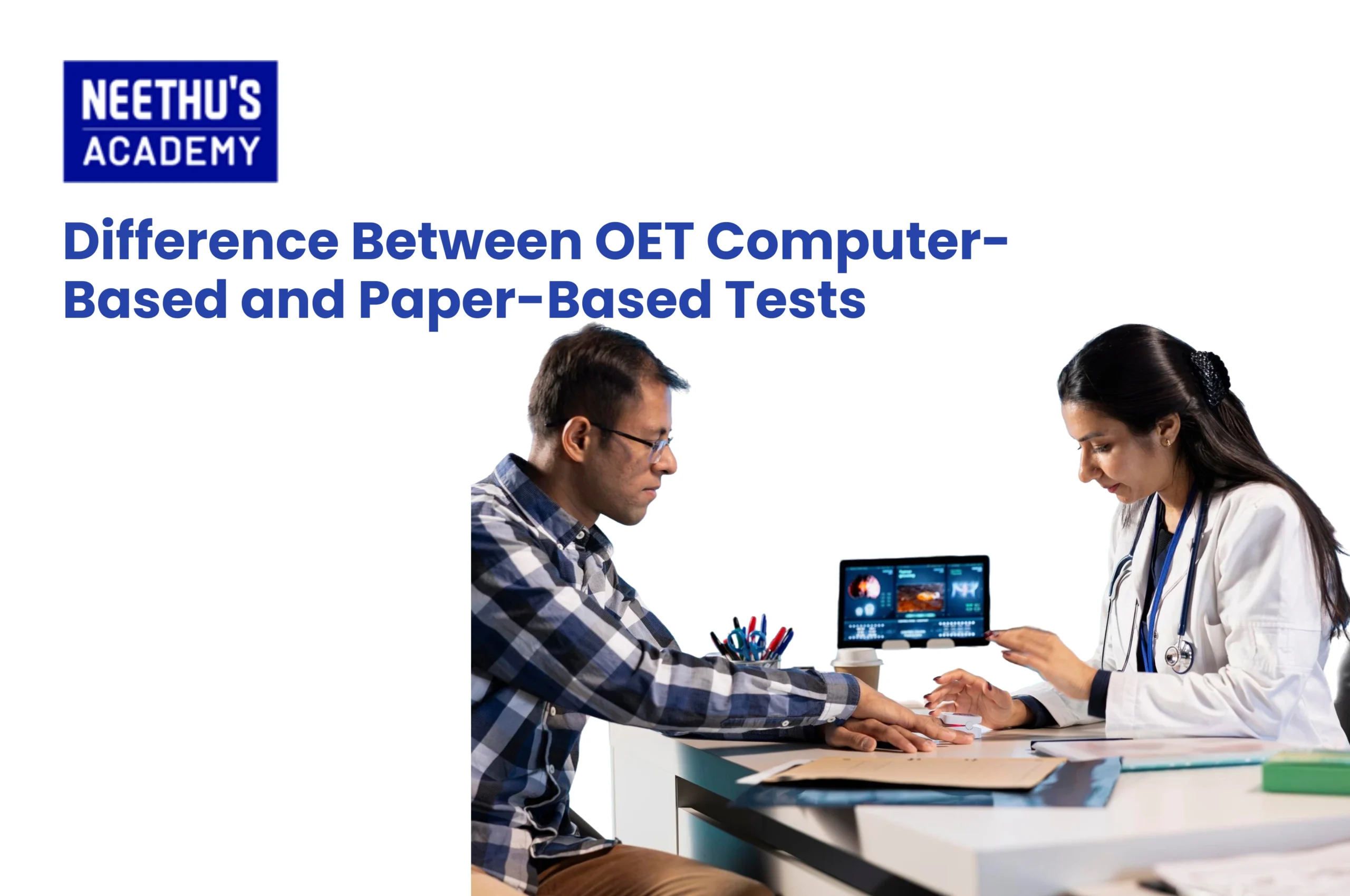The Occupational English Test is an entry pass for health care providers, including pharmacists, showing proof of proficiency in using English in…

Difference Between OET Computer-Based and Paper-Based Tests
The Occupational English Test (OET), which is for healthcare professionals, has been a reliable indicator of clinical English communication skills for some time. Historically, it was delivered in paper-based mode, but with the advance of technology and the move towards flexible testing globally, OET introduced the computer-based mode to provide candidates with greater convenience, access, and quicker results.
The OET online test (2025) now provides the same credibility and structure as the paper-based version but with added flexibility for test-takers worldwide. Understanding the differences between the two modes helps candidates choose the best fit based on comfort, location, and test-taking style.
Format Comparison of Both Versions
For OET computer vs paper test, the content, structure, and marking are the same. Both modes test the four language skills—Listening, Reading, Writing, and Speaking—within the health profession context. The only difference is in the mode of delivery and test environment.
Here’s how both formats differ in more detail:
Listening:
- Computer-based: You listen with headphones and respond directly on-screen.
- Paper-based: You hear through loudspeakers and write answers by hand on the answer sheet.
Reading:
- Computer-based: You read and respond to questions on screen using highlight and scroll functions.
- Paper-based: You page through printed booklets and mark answers in handwriting.
Writing:
- Computer-based: You write your letter using a keyboard in a text box.
- Paper-based: You complete the letter in handwriting on lined paper.
Speaking:
- Both modes: Administered one-to-one with an interlocutor (either in person at a test centre or via Zoom for remote candidates).
The content, level of difficulty, and marking criteria remain the same for both modes. The only variation is the channel by which candidates express their responses.
Advantages and Disadvantages of Each Mode
Each version of the OET has unique benefits and challenges. The ideal choice depends on your personal comfort level, typing speed, and familiarity with digital exams.
Advantages of the Computer-Based OET
- Faster results: Scores are usually released within 10–12 business days.
- More test dates: The OET online test 2025 offers greater flexibility with frequent sessions.
- Digital convenience: Typing is often faster and more legible than handwriting.
- Clear audio quality: Individual headphones eliminate background noise during Listening.
- Easy editing: The Writing section provides easy correction without messy erasures.
Disadvantages of the Computer-Based OET
- Needs digital skills: Some basic typing and computer navigation skills are required.
- Screen fatigue: Long periods of reading or typing can lead to eye strain.
- Limited availability of centers: Online testing centers are not yet available in all countries.
Advantages of the Paper-Based OET
- Classic ease: Suitable for candidates accustomed to handwritten tests.
- Less screen fatigue: Reading and writing on paper are more natural for most candidates.
- Comfort environment: Physical access to materials is comforting for some test-takers.
Drawbacks of the Paper-Based OET
- Delayed results: Generally takes longer (up to 16 business days).
- Readability problems: Bad handwriting can result in misinterpretation in the Writing task.
- Fewer test dates: Paper-based sessions are less common than computer-based ones.
Which Mode is Better for Nurses?
For nurses and healthcare professionals, the best mode is based on individual strengths.
If you prefer to type and are looking for quicker results, the OET computer-based version is the best. It reflects contemporary healthcare documentation, wherein electronic medical records are used routinely. Nurses employed in tech-enabled hospitals can also identify with the digital mode as being closer to their actual working environment.
But if you prefer pen-and-paper writing and are not as comfortable with computers, the paper-based OET is a safe bet. Both formats are of equal value and recognized by regulatory authorities such as the Nursing and Midwifery Council (NMC) and Australian Health Practitioner Regulation Agency (AHPRA).
How Scoring Differs Between Computer and Paper Modes
Comparing OET mode scoring, it’s important to observe that there is no scoring bias between both modes.
The OET computer vs paper test applies the same marking scale and criteria to all sub-tests. Answers are marked by trained human assessors—Listening and Reading are auto-marked, whereas Writing and Speaking are marked by accredited OET examiners.
For Writing, typed responses are graded the same way written responses are, with emphasis placed on structure, tone, and clarity instead of handwriting. The OET computer-based scoring system is fair through standardized marking software that replicates the accuracy of paper tests.
Tips for Computer-Based Test-Takers
Should you take the OET online test 2025, these are some important tips to do your best:
- Practice typing: Build comfort with typing speed and accuracy for the Writing section.
- Use official OET practice software: Familiarize yourself with the digital interface to avoid surprises on test day.
- Learn navigation tools: Understand how to highlight, scroll, and switch between screens efficiently.
- Check your equipment: Ensure your computer, microphone, and internet connection meet OET’s technical requirements (if testing remotely).
- Take breaks from screens: Regular breaks during preparation to avoid eye fatigue.
- Self-time digitally: Take full-length practice tests to accustom yourself to real-time timing.
- Headphones listening: Familiarize yourself with digital sound for practice with the online Listening test.
With these tips, you will get acclimatized easily and confidently navigate the OET computer-based test environment.
Conclusion
In the case of the OET computer test vs paper test, both are equally acceptable and recognized by prominent healthcare boards internationally. The decision is based on your personal preference, resources, and testing habit.
If you prioritize speed, convenience, and state-of-the-art technology, then the OET online test 2025 is your best bet. If you are more comfortable writing with paper and pen and like a more classic setting, the paper-based test is a reliable option.
Ultimately, the most successful OET format is the one that gives you the chance to perform with confidence and showcase your optimal English proficiency without distraction.
Frequently Asked Questions
Yes, computer-based and paper-based OET results are equally accepted by the NMC.
No, both modes have the same level of difficulty and assessment criteria.
You are not able to switch test mode after you have booked; you need to cancel and rebook.
Speaking tests are conducted via Zoom with a live interlocutor in simulated face-to-face interaction.
Related Blogs
- All Posts
- OET
Among the several components of the OET, the Speaking sub-test is crucial and evaluates your proficiency not only in language but also…
Preparing for the Occupational English Test (OET) can be a game-changer for nurses aiming to advance their careers globally. At Neethu’s Academy,…
Course Enquiry
Error: Contact form not found.
Latest Posts
- All Posts
- canada
- CBT
- DELF
- DHA
- French
- GENERAL
- German
- Haad
- IELTS
- IQN NEW ZEALAND
- MOH
- NCLEX-RN
- NHRA
- OET
- OSCE
- Pearson Vue
- PROMETRIC
- PTE
- TOEFL
- Back
- NCLEX - NGN
- Back
- OET FOR PHYSIOTHERAPIST
- OET FOR PHARMACIST
- OET FOR DOCTORS



- Completely online; can take from home with computer, internet, and webcam.
- Adaptive test format – questions become harder or easier based on answers.
- Speaking, reading, listening, and writing in short interactive tasks.
- Score range: 10–160, and universities usually require 105–125.
